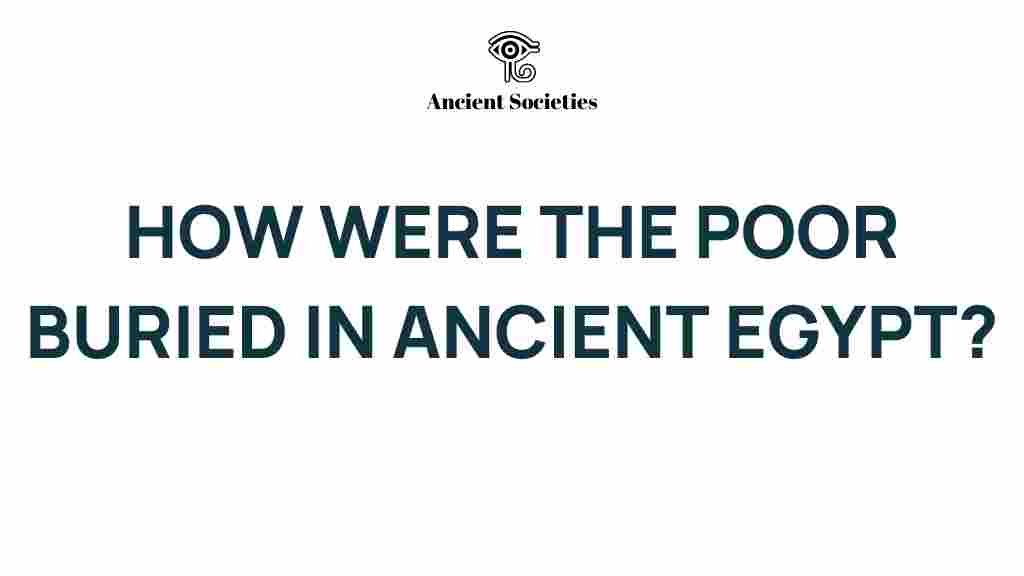Unearthing the Secrets: How the Poor Were Buried in Ancient Egypt
The study of Ancient Egypt offers a fascinating glimpse into the lives of its inhabitants, particularly their burial practices. While the lavish tombs of pharaohs and nobles often steal the spotlight, the burial customs of the poor reveal much about the social hierarchy and cultural beliefs of this ancient civilization. In this article, we will explore the burial practices of the lower classes in Ancient Egypt, examining their significance in the context of poverty, archaeology, and history.
The Social Hierarchy of Ancient Egypt
Understanding the burial practices of the poor in Ancient Egypt requires a brief overview of the social hierarchy. Ancient Egyptian society was stratified, with a clear distinction between the wealthy elite and the impoverished majority. The social classes included:
- Pharaohs and Nobility: The ruling class enjoyed opulent lifestyles, with grand tombs filled with treasures.
- Priests: Responsible for religious rituals, they held significant power and wealth.
- Artisans and Merchants: Skilled workers and traders who contributed to the economy.
- Farmers and Laborers: The backbone of society, often living in poverty.
The burial customs of the lower classes reflected their social standing and economic circumstances. Unlike the elaborate tombs of the elite, the poor had simpler, more modest burial practices.
Funerary Customs of the Poor
In Ancient Egypt, funerary customs were deeply intertwined with cultural beliefs about the afterlife. The Egyptians believed that the deceased would embark on a journey after death, necessitating certain practices to ensure a safe passage. Here’s how the poor were buried:
1. Location of Burials
Most poor Egyptians were buried in communal graves or simple pits rather than individual tombs. These graves were often located near their homes or in designated burial grounds outside urban areas. The lack of resources meant that elaborate tombs were reserved for the wealthy.
2. Simple Grave Goods
While the wealthy were buried with vast treasures, the poor were usually interred with only a few essential items. Common grave goods included:
- Pottery and cooking utensils
- Simple jewelry made from inexpensive materials
- Food offerings, such as bread and beer, to sustain them in the afterlife
These items reflected the daily lives of the deceased, emphasizing their humble existence.
3. Burial Practices
The body of the deceased was typically wrapped in linen or placed in a simple wooden coffin, if available. Mummification was not common among the poor due to the costs associated with it. Instead, the body would often be buried quickly after death, sometimes with minimal preparation.
The Role of Archaeology in Understanding Burial Practices
Archaeology plays a crucial role in unveiling the burial practices of the poor in Ancient Egypt. Excavations of burial sites have provided valuable insights into the lives of these individuals. Archaeologists study:
- The layout and contents of graves
- The materials used in burial goods
- The location and arrangement of graves
These findings help reconstruct the social dynamics and cultural beliefs surrounding death and the afterlife in Ancient Egypt. Click here to learn more about the archaeological discoveries in Ancient Egypt.
Poverty and Its Influence on Burial Customs
Poverty significantly influenced the burial customs of the poor in Ancient Egypt. Limited resources meant that families often had to make difficult choices regarding how to honor their deceased. The following factors highlight the impact of poverty on funerary practices:
- Affordability: Many families could not afford elaborate funerals or grave goods.
- Community Support: In times of loss, communities often banded together to provide support, pooling resources for basic burial needs.
- Practicality: Quick and simple burials were often the norm, reflecting the harsh realities of life.
The simplicity of these funerals did not diminish their significance; they were meaningful acts of remembrance within the constraints of poverty.
Common Misconceptions
There are several misconceptions about the burial practices of the poor in Ancient Egypt. Addressing these can provide a clearer understanding:
1. All Burials Were Elaborate
Many people assume that all ancient Egyptian burials were elaborate. However, the reality was far more complex, with the poor often receiving simple burials.
2. Lack of Belief in the Afterlife
Some believe that the poor did not subscribe to the cultural beliefs surrounding the afterlife. In fact, even those with limited means often participated in rituals and customs that reflected their hopes for the afterlife.
3. Inferior Funerary Customs
Another misconception is that poor funerary customs were inferior or less meaningful. In reality, these practices were deeply rooted in cultural beliefs and held significant emotional weight for families.
Conclusion
Unearthing the secrets of how the poor were buried in Ancient Egypt reveals much about the society’s cultural beliefs, social hierarchy, and the realities of poverty. Through archaeological findings, we can glimpse the lives of those who often went unnoticed in history. Their burial practices, while modest, were rich in significance and reflect a deep reverence for the deceased and the hope for a continued existence beyond death.
Understanding these customs not only enriches our knowledge of Ancient Egypt but also highlights the shared human experience of loss and remembrance, transcending time and social class.
As we continue to explore the depths of Ancient Egypt, we invite you to reflect on the stories of all those who lived—rich and poor alike—each contributing to the tapestry of history.
For further reading on the fascinating world of Ancient Egypt, including its burial practices and social structures, visit this resource.
This article is in the category Archaeology and created by AncientSocieties Team
